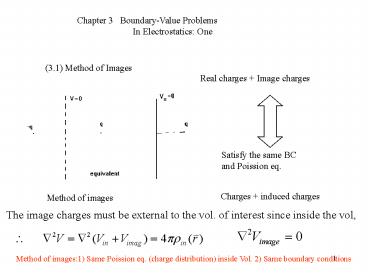Chapter 3 Boundary-Value Problems - PowerPoint PPT Presentation
1 / 26
Title:
Chapter 3 Boundary-Value Problems
Description:
Chapter 3 Boundary-Value Problems In Electrostatics: One (3.1) Method of Images Real charges + Image charges Satisfy the same BC and Poission eq. – PowerPoint PPT presentation
Number of Views:125
Avg rating:3.0/5.0
Title: Chapter 3 Boundary-Value Problems
1
Chapter 3 Boundary-Value Problems
In Electrostatics One
(3.1) Method of Images
Real charges Image charges
Satisfy the same BC and Poission eq.
Charges induced charges
Method of images
The image charges must be external to the vol.
of interest since inside the vol,
Method of images1) Same Poission eq. (charge
distribution) inside Vol. 2) Same boundary
conditions
2
3.2 Point charge in the presence of a grounded
conducting sphere
Question Seek the potential V(r) in the case
that a point charge q located
at rq near a grounded
conducting sphere with radius a.
A grounded conducing sphere means that
Image system
The potential due to the charge q and q
.
Original system
We now try to find q and
such that this potential satisfies
3
---- a unit vector in the direction
-- a unit vector in the direction
Then we find the position and the magnitude of
the image charge
4
(1) The induced charge density
Where g is the angle between and
5
(2) The force between the sphere and q
Method 1
Method 2
da
g
q
6
The force between a point charge and its induced
charges
q
A conducting plane
Then the force on each element of area is given by
7
3.3 Point charge in the presence of a
charged, insulated conducting sphere
Start with the grounded conducting sphere (q)
disconnect the ground wire and add (Q-q)
Q
8
3.4 Point Charge Near a Conducting Sphere at
Fixed Potential
so long as the charge (Q-q) on the surface is
replaced by a charge V0 a
9
3.5 Conducting Sphere in a Uniform Electric Field
A uniform can be thought of as being
produced by appropriate position and negative
charges at infinity. in a region near the origin
whose dimensions are very small compared to R
In the limit as
constant, this approximation becomes exact.
10
If now a conducting sphere of radius a is placed
at the origin, the potential will be due to the
charges
at
and their images at
11
12
In the limit
, the potential becomes
The induce charge density is
13
3.6 Greens Function for the Sphere General
Solution
Green function the potential due to a unit
charge and its image
In
--- the location P of the unit charge
-- the point p the potential is being evaluated
In terms of spherical coordinates,
In terms of spherical coordinates
14
G0 if either
or
on S
Then formal solution is given by
,
then
We need not only
, but also
.
15
Hence the sol. of Laplace eq. outside a sphere
with the potential specified on S is
where
16
3.7 Conducting Sphere with Hemisphere at
Different Potentials
17
We can change the variables in the second
integral,
it can not in general be integrated in closed
form.
18
As a special case, we consider the potential on
the positive z axis. Then
, since
.
Two cases
19
In the absence of a closed expression for the
integral, we can expand the denominator in power
series and integral term by term
In the expansion, only odd powers of
( ) will appear.
20
Since
21
If the expansion parameter is
rather than
For
, converges rapidly and so is useful Even for
the 2nd term is only of the order of 2.
(Legendre polynomial of odd order)
22
3.8 Orthogonal functions and expansions
Consider a set of real or complex functions fn(x)
(n1,2,.) on the interval (a,b), if
(orthonormal)
and
(completeness)
Then fn(x) form a complete set of orthogonal
functions, it means that any well-behaved
function F(x) can be expressed by a series
Where the coefficients
23
Typical examples Functions form a complete set
of orthogonal functions
Fourier series
where
Fourier integral
The Legendre polynomials
The spherical Harmonics The Fourier-Bessel series
Which one? The particular orthogonal set chosen
depends on the symmetries or near symmetries
involved
24
3.9 Separation of variables Laplace equation in
rectangular coordinates
The Laplace equation in rectangular coordinates
Is correct for arbitrary values of the
independent coordinates,
Where
Then the solutions of the three ordinary
differential equations are
25
The potential can thus be built up from the
product solutions
At this stage a,b are completely arbitrary. To
determine a,b it is necessary to impose specific
boundary conditions on the potential.
z
Consider a rectangle box with dimensions (a,b,c)
in the (x,y,z) directions. All surfaces of the
box are kept at zero potential, except the
surface zc, which is at a potential V(x,y). It
is required to find the potential everywhere
inside the box.
zc
yc
y
xa
x
26
To have F0 at xa and yb, we must have aanp,
and bbmp. Then
Since FV(x,y) at zc
We have the coefficients































